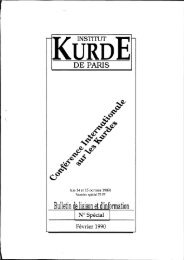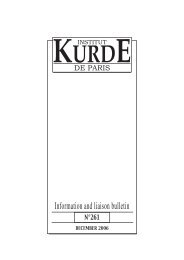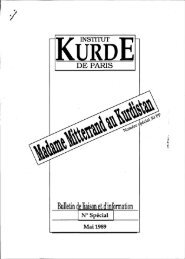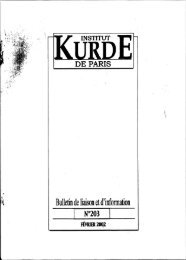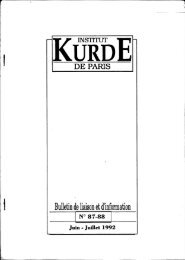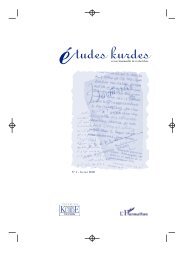Bulletin de liaison et d'information - Institut kurde de Paris
Bulletin de liaison et d'information - Institut kurde de Paris
Bulletin de liaison et d'information - Institut kurde de Paris
You also want an ePaper? Increase the reach of your titles
YUMPU automatically turns print PDFs into web optimized ePapers that Google loves.
Revue <strong>de</strong> Presse-Press Review-Berhevoka Çapê-Rivista Stampa-Dentro<br />
<strong>de</strong> la Prensa-Baszn Öz<strong>et</strong>i<br />
sents a mother's life-sized hands holding<br />
a thumb-sized photo ofher <strong>de</strong>ad son, a fitwere<br />
hero-worshipers. When their muchphotographed<br />
lea<strong>de</strong>rs were hanged or exiled,<br />
political movements often collapsed.<br />
In the 1910s, Great Britain encouraged<br />
Iraqi Kurds to <strong>de</strong>velop writing, the key to<br />
mo<strong>de</strong>rn culture. But oil soon led the Kurds'<br />
protectors to b<strong>et</strong>ray and then in 1924 to<br />
bomb them. Meiselas has the goods on the<br />
British in their own words-diplomatic<br />
cables,journals and l<strong>et</strong>ters. Kurdish writing<br />
and print surfaced again. in the Mababad<br />
Republic, the only Kurdish state. Carved<br />
out of Iran in 1945, represented by documents<br />
and photos of po<strong>et</strong>s in Kurdistan,<br />
Mahabad was reabsorbed in 1946. Farsi,<br />
Arabic and Turkish had the power to suppress<br />
an upstart language. After Mab~bad,<br />
Kurds in Iraq were not allowed typewnters.<br />
In the fifties, only Kurds in the Sovi<strong>et</strong> Union<br />
had access to printing presses. Tothis day,<br />
Turkey and Iran forbid education in Kurdish<br />
dialect, and Turkey <strong>de</strong>nies the validity<br />
of the word "Kurd," calling eastern citizens<br />
"Mountain Turks." In this mid-century<br />
III TBIS REVIEW<br />
ImISTAI: lalla. SIa•••• II Blsllry.<br />
Edited by Susan Meiselas.<br />
Random House. 388 pp. $100.<br />
Ami SaCBDOmBCE, WUT<br />
FOICßEIESS?: M, E.clul.n<br />
Willaluitslu.<br />
By Jonathan C. Randal.<br />
Farrar, Straus & Giroux. 356 pp. $25.<br />
ATATÏU'S CBD.DIEI:Tark.,<br />
••• Ih. lar.s.<br />
By Jonathan Rugman and Roger<br />
Hutchings.<br />
Cassell. 128 pp. $45.<br />
ImISTU.<br />
Photos by N. Kasraian; text by<br />
Z. Arshi and K. Zabihi.<br />
Oriental Art Publishing. 139 pp.<br />
$76.50.<br />
period, many of Meiselas's photograp~s<br />
were taken by Western military men, engIneers,<br />
journalists and other colonial scouts.<br />
When Kurds could afford cameras of<br />
their own, photography became a suspect<br />
and dangerous occupation, capable of<br />
un<strong>de</strong>rmining massive print propaganda.<br />
A Kurdish photographer in Iraq recounts<br />
the 1962 arrest of his cousin for carrying<br />
a photo; he was jailed for ten days. In Iran.<br />
photographs were <strong>de</strong>stroyed in 1974 because<br />
they were "cultural products." N egatives<br />
were buried in backyards, un<strong>de</strong>veloped<br />
for <strong>de</strong>ca<strong>de</strong>s, and some are now printed<br />
in Kurdistan. Fearful ofusing cameras,<br />
Kurds tound cameras used against them. A ting emblem for Meiselas's project.<br />
1984 newspaper photo, obviously staged For all their affecting <strong>de</strong>tail, photographs<br />
for propaganda, shows Kurds surroun<strong>de</strong>d can only witness. Sixteen chapter introductions<br />
and humiliated by Turkish troops. Meiselas<br />
by Martin van Bruinessen-the<br />
also inclu<strong>de</strong>s 1990 photos of Kurdish Kurdish-speaking author of Agha. Shaikh<br />
villagers wearing numbers, easy i<strong>de</strong>ntification<br />
and State: The Social and Political Struc-<br />
for Turkish police files.<br />
tures of Kurdistan~o a fine, objective<br />
job of clarifying political movements and<br />
Ifthe technology of the Iranian revolution diagnosing Kurds' friendlessness. Because<br />
was the cass<strong>et</strong>te and of the Chinese ~tu<strong>de</strong>nt<br />
uprising the fax, Kurds broke mto of the United States, the material on the<br />
Iran and Iraq have been avowed enemies<br />
Western consciousness with bleary vi<strong>de</strong>otape-{)f<br />
<strong>de</strong>ad children, their :yes wi~e distan is relatively familiar. More com-<br />
recent history of those countries in Kur-<br />
open, gassed in the stre<strong>et</strong>s of Iraq s Hala?Ja pelling are the sections on Turkey, America's<br />
in 1988-and with this <strong>de</strong>ca<strong>de</strong>'s ma gaz me<br />
only friend in the region. Striking<br />
photographs, in vivid color. Compiling this photographs, legal documents, newspapers,<br />
history, contributing to it with photos of her oral histories and van Bruinessen's miniessays<br />
own, Meiselas also implies the limits of her<br />
<strong>de</strong>monstrate just how similar our<br />
profession. She inclu<strong>de</strong>s a Canon ad using ally is to Iraq un<strong>de</strong>r Saddam. In the past ten<br />
a photograph of a Kurdish guerrilla, rebellion<br />
years, the Turkish military has <strong>de</strong>stroyed<br />
commodified just as exotic difference hundreds of Kurdish villages near Iraq<br />
was in much earlier postcards of Kurdish and Iran, killearties that would be out<br />
noose in 1947.<br />
ofplace in Meiselas's project. But Randal's<br />
The chain on an Iraqi prisoner in 1948 is best chapters are about U.S. involvement in<br />
thick enough to pull a German-ma<strong>de</strong> Turkish<br />
Kurdistan. He shows in persuasive insi<strong>de</strong>r<br />
tank confronting a Kurdish woman and <strong>de</strong>tail how Nixon, Kissinger and the Shah of<br />
childin 1993. There's a page from an alphab<strong>et</strong><br />
Iran b<strong>et</strong>rayed a Kurdish uprising against<br />
book banned by Turkey in 1968, a photo Saddam Hussein in 1975; how Bush, Baker<br />
ofSaddam in Kurdish costume, Meiselas ' s and feckless diplomats both "suckered"<br />
1991 shot of an American forensic anthropologist<br />
the Kurds into rebellion after the Gulf<br />
standing in an Iraqi grave, hold-<br />
War and waffled on aiding them; and how<br />
ing in his bare hands a blindfol<strong>de</strong>d Kurdish<br />
the Clinton Administration might have<br />
skull, a too-late Haml<strong>et</strong> to a too-real brokered a s<strong>et</strong>tlement in northern Iraq in<br />
Yorick. More than any photographer inclu<strong>de</strong>d,<br />
1996 instead of allowing a civil war and<br />
the editor knows the power of close-<br />
then airlifting thousands offriendly Kurds<br />
ups and blow-ups, the allegory of the superspecific.<br />
to Guam. Randal' s chapter on Turkey re-<br />
The last of her nine color photos cords how the United States has in recent<br />
and the penultimate image in Kurdistan pre-<br />
years skirted its own laws restricting arms<br />
sales to human rights abusers and ma<strong>de</strong><br />
Turkey "the biggest single importer of<br />
49





